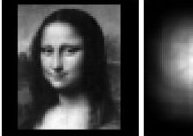

Researchers for the company, David Stork and Patrick Gill won a Best Paper award at last year's Sencomm 2013 for describing what the company has created. They spoke again at last month's Mobile World Congress, describing their new type of camera—one that might someday soon be used to give virtually any digital device, some degree of vision.
he camera is both simple and complex, it's really just a very tiny chip (CMOS imager) embedded in a piece of glass. Instead of a lens, a pattern is etched into the glass above the chip—the imager reads the light that is received, processes it using an algorithm developed by Rambus and converts it into a recognizable image. What's amazing is that the etched pattern on the glass and the chip are both roughly the size of a period at the end of a sentence.
Particular etched patterns allow for light to be intentionally refracted in different ways as it passes through the glass—images made from them would appear unrecognizable to the human eye, but the algorithm makes use of refraction properties to reconstruct the light received into a recognizable image.
The whole point of the camera is to show that cameras can be made smaller than has been envisioned by engineers of late. Trying to grind ever smaller lenses has reached its limits, thus something new had be developed. The camera by Rambus is one such possibility. Its images are not sharp—in fact at a resolution of just 128x128, its images are downright blurry—but at this point, that doesn't matter, because images taken by the camera are recognizable, and that's all digital devices of the near future likely need. Perhaps just as remarkable is that the tiny camera can be used to capture real-time video too, which makes it a likely candidate for future motion sensing devices.
Making a camera so tiny opens the door for its use in a whole host of new applications, allowing them to become aware of their physical surroundings, all at a very low cost—perhaps just pennies per chip—that means they could be embedded in clothes, toys, mirrors, security systems, etc., bounded only by the imagination of device makers. On the other hand, such tiny cameras could also open a Pandora's box if they are used to invade privacy or for control purposes.
Read more at: http://phys.org/news/2014-03-ultra-tiny-camera-lens-algorithm.html#jCp